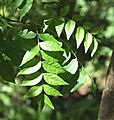Pistacia facts for kids
Quick facts for kids Pistacia |
|
|---|---|
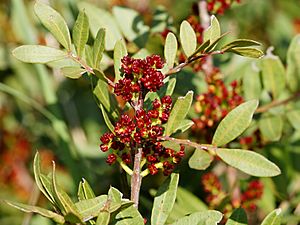 |
|
| Pistacia lentiscus | |
| Scientific classification |
|
| Kingdom: | Plantae |
| Clade: | Tracheophytes |
| Clade: | Angiosperms |
| Clade: | Eudicots |
| Clade: | Rosids |
| Order: | Sapindales |
| Family: | Anacardiaceae |
| Subfamily: | Anacardioideae |
| Genus: | Pistacia L. |
| Species | |
|
See text |
|
| Synonyms | |
|
Terebinthus Mill. |
|
Pistacia is a group of flowering plants in the cashew family, called Anacardiaceae. There are about 10 to 20 different kinds, or species, of Pistacia plants. They grow naturally in many parts of the world. You can find them in Africa, Europe, and Asia. They also grow in North America, from Mexico up to warm, dry areas of the United States like Texas and California.
Contents
What are Pistacia Plants Like?
Pistacia plants are usually shrubs or small trees. They can grow to be about 5 to 15 meters (16 to 49 feet) tall. Their leaves grow in a special way, with smaller leaflets arranged along a stem. Some species have leaves that stay green all year (evergreen). Others lose their leaves in the fall (deciduous).
Male and Female Plants
Most Pistacia species have separate male and female plants. This means you need both a male and a female tree for them to make seeds. This is called being dioecious. It's a bit like how some animals have males and females.
How Old is the Pistacia Group?
Scientists believe the Pistacia group of plants is very old. They estimate it started about 80 million years ago!
Famous Pistacia Plants
You might know some Pistacia plants already!
- The most famous is Pistacia vera, which gives us the yummy pistachio nuts we eat.
- P. terebinthus is used to make a type of turpentine called terebinth resin.
- P. lentiscus is the source of a special plant resin called mastic.
- P. chinensis, or the Chinese pistache, is grown as a pretty tree because its leaves turn bright red in autumn.
Pistacia Species Around the World
There are many different kinds of Pistacia plants. Here are some of them:
| Image | Scientific Name | Common Name | Where it Grows |
|---|---|---|---|
| Pistacia aethiopica | Ethiopia, Kenya, Somalia, Tanzania, Uganda, and Yemen. | ||
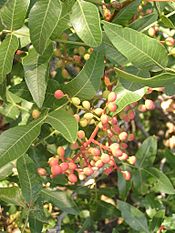 |
Pistacia atlantica | Betoum | Eurasia from the Iranian Plateau to North Africa |
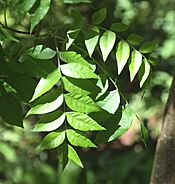 |
Pistacia chinensis | Chinese pistache | Central and western China. |
| Pistacia cucphuongensis | Vietnam. | ||
| Pistacia eurycarpa | Zagros Mountains, Iraq | ||
| Pistacia falcata | Northeast Tropical Africa, Arabian Peninsula | ||
| Pistacia khinjuk | Egypt, western Asia and parts of the Himalayas | ||
| Pistacia integerrima | Asia | ||
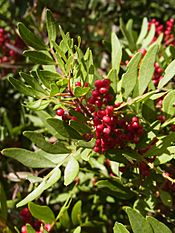 |
Pistacia lentiscus | Mastic | Mediterranean region |
| Pistacia malayana | Peninsular Malaysia. | ||
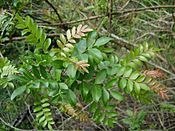 |
Pistacia mexicana | Mexican pistache | Guatemala, Mexico, and Texas |
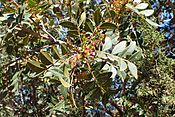 |
Pistacia saportae | Europe | |
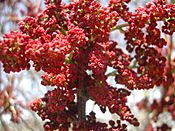 |
Pistacia terebinthus | Terebinth | Morocco, Portugal, Greece, Turkey, and the Middle East. |
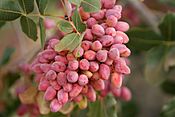 |
Pistacia vera | Pistachio | Central Asia and the Middle East |
| Pistacia weinmannifolia | Yunnan province of China |
Where Pistacia Plants Grow Best
Pistacia plants are very tough. They are often found in dry places or areas with hot summers, like the Mediterranean climate. They can handle not having much water and can grow in salty soil. Some can even grow in soil with 3% to 4% salt!
Temperature and Soil Needs
These plants are very resilient. They can survive cold winters down to about -10°C (14°F) and hot summers up to 45°C (113°F). They like sunny spots and soil that drains water well. Even though they are hardy and can handle dry spells, they grow slowly. It takes about 7 to 10 years for them to start producing fruit. They reach their full size after 15 to 20 years.
Water and Health
While some Pistacia species like a bit of moisture, they don't do well in very humid places. Too much water or poorly draining soil can make them sick. They can get root rot or other plant diseases. They actually need a dry period each year to grow properly.
Flowers and Fruit
Pistacia plants have small flowers that don't have petals. They are grouped together in clusters and can be purple or green. The fruit is a small, round fruit called a drupe, which is like a tiny plum or cherry. It's usually about the size of a pea and changes from red to brown as it ripens. Most of these fruits are not tasty for humans.
Seeds and Animals
The seeds inside the fruit are eaten and spread by birds. These seeds are an important food source for birds, especially when food is scarce, like during breeding season or migration. The pistachio nuts we eat come from the Pistacia vera species, which has much larger, edible fruits.
Smell and Galls
Many Pistacia plants give off a strong, sometimes bitter or medicinal, smell. This comes from the resin they produce. Some species also get "galls" on their leaves. These are strange bumps that form after insects bite the leaves. Even with galls, these plants are very strong and can survive in damaged areas where other plants might not.
How They Spread
Pistacia plants can spread in different ways. They can grow from seeds, or they can send out new shoots from their roots or underground stems (stolons). Different Pistacia species can also mix together and create hybrid plants, which can be hard to identify.
Uses of Pistacia Plants
Pistacia plants have been useful to humans for a very long time.
The Famous Pistachio
The best-known Pistacia plant is Pistacia vera, the pistachio tree. It's originally from Iran. We grow it for its delicious seeds, which are the pistachio nuts. In ancient times, people also ate the seeds from other Pistacia species, but those seeds are too small to be valuable today.
Terebinth Resin
Pistacia terebinthus, or the terebinth tree, grows in Iran and countries around the western and eastern Mediterranean Sea. People tap this tree to get its resin, which is used to make turpentine. Ancient people also used terebinth resin to help preserve wine because it could kill certain bacteria. In Iran, archaeologists found terebinth resin from about 5400 to 5000 BC in jars that also had grape juice left over. This is one of the earliest signs of winemaking!
Mastic Resin
Pistacia lentiscus is an evergreen shrub or small tree found in the Mediterranean region. It provides a special resin called mastic.
Chinese Pistache as an Ornamental Tree
Pistacia chinensis, known as the Chinese pistache, is the Pistacia species that can handle the most frost. It's often planted as a beautiful ornamental tree because its leaves turn a bright, fiery red in the autumn.
Images for kids
See also
 In Spanish: Pistacia para niños
In Spanish: Pistacia para niños






